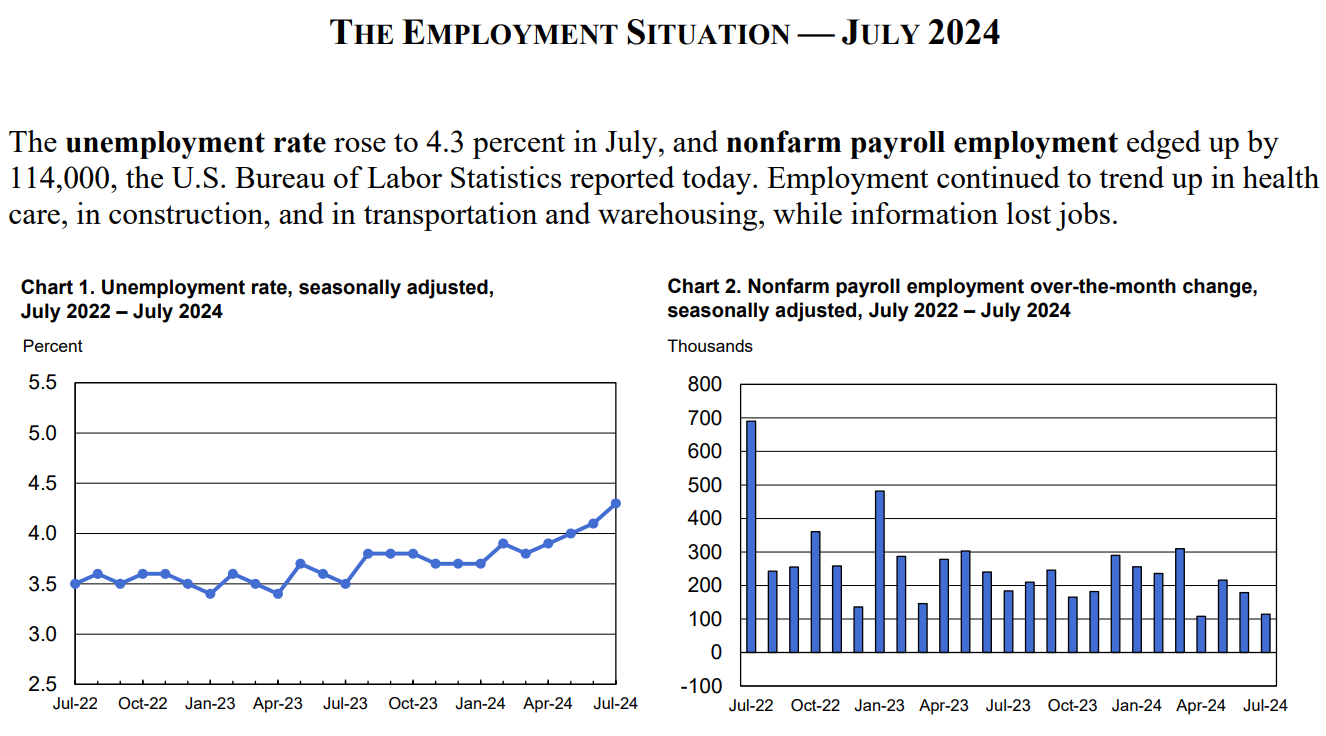
"*" indicates required fields
"*" indicates required fields
"*" indicates required fields



The freight market followed typical seasonal trends in late July and early August as demand and rates eased from peak season levels. Capacity continued contracting slowly but remains sufficient to service demand. Thus, the market continues to move towards equilibrium and should follow normal seasonal patterns for at least the near term.
The Canadian rail strike has been resolved through binding arbitration imposed by the Canadian Industrial Relations Board (CIRB), effectively ending the strike notice issued by CN on Friday. As a result, CN and CP workers have returned to work and rail operations are back online. Although the teamsters union plans to appeal the decision, the government’s decisive intervention suggests that the appeal will be unsuccessful. While over-the-road (OTR) disruptions may continue into next week, the situation is stabilizing and conditions should return to normal soon.
"*" indicates required fields
Spot postings increased year-over-year but declined slightly month-over-month.
Overall trucking employment numbers continue to decline, indicating capacity is undergoing attrition due to poor market conditions. However, overall supply levels remain elevated.
Import levels are strong, resulting in outbound Southern California rail volumes peaking. Potential East and Gulf Coast port strikes in October could spark additional West Coast demand to overflow to truckload if they occur.
Rates continue to follow seasonal patterns, returning to pre-Fourth of July levels.
The growing gap between private fleets’ operating cost per mile and current spot and contract rates will lead to decreased investment in private fleets and a portion of overall demand returning to the for-hire market.
Inflation fell below 3% for the first time since 2021, increasing the likelihood that the Fed will begin its rate-cut cycle in September, a potential upside risk for freight demand.
What’s Happening: Demand remains relatively flat.
Why It Matters: Rates are flat in turn.
The Sonar Contract Load Accepted Volume Index (CLAV) measures accepted load tenders moving under contractual agreements. It is similar to the Outbound Tender Volume Index (OTVI) but removes all rejected tenders.
As of early August, the CLAV index showed contract volumes have pulled back from June and early July highs to levels seen in May. When accounting for tender rejections, volumes are down 2.7% month-over-month. Dry van and reefer also declined by 1.4% and 2.0%, respectively.

DAT reports that spot load postings declined 7.0% from June to July but rose 5.9% compared to July 2023, when postings fell by nearly 20% month-over-month and over 50% year-over-year. This data indicates conditions are stabilizing in today’s environment and moving closer to equilibrium.
Truck postings moved in the opposite direction, rising by 6.5% month-over-month, indicating easing spot demand. However, they fell over 10% from July 2023, likely representative of the overall spot capacity decline.

The Cass Freight Index shipments component is a good indicator of overall market health because it encompasses both spot and contract freight based on bill data. The July reading showed shipments increased by 3.1% month-over-month on a seasonally adjusted basis, illustrating a different trend than the FreightWaves and DAT data indicate. This could be for a number of reasons, but ultimately, it points to demand increasing above typical seasonal patterns.
On an annual basis, July shipments were down 1.1% from 2023 and nearly 10% from July 2022. While volume remains steady today, this data indicates challenging conditions will continue for carriers with no imminent inflationary flip in sight as capacity reductions have not eased at the same rate as demand.

What’s Happening: Supply is strong, and tender rejections are low.
Why It Matters: With ample capacity, the market is safe from rapid rate increases.
While obtaining precise capacity data remains challenging, recent trends and flattening rates indicate that the market has stabilized following some volatility around the Fourth of July.
The Sonar Outbound Tender Reject Index (OTRI), which measures the rate at which carriers reject the freight they are contractually required to take, shows more volatility now than at this time last year. Tender rejections and rates were flat in late July and early August, and rejections continue to reflect 2019 mid-year trends. Flattening rejection rates likely stem from steady demand trends and slow capacity attrition.
Reefer rejection rates are higher than a year ago, when the Q3 harvest season created volatility. Elevated rejection rates could create challenges for shippers as volatility increases around Labor Day and the end of Q3.


The DAT Load-to-Truck Ratio measures the total number of loads relative to the total number of trucks posted on its spot board. The dry van reading fell to 4.18 in July, a slight slip from June and the first decline following four consecutive months of increases. Despite the month-over-month drop, the ratio remains slightly elevated relative to previous years. The reefer load-to-truck ratio fell to 6.52 but remains slightly above the July 2023 reading.

The Morgan Stanley Dry Van Freight Index is another measure of relative supply; the higher the index, the tighter the market conditions. The black line with triangle markers on the chart provides a great view of what directional trends would be in line with normal seasonality based on historical data dating back to 2007.
The most recent reading in mid-August showed trends following the 10-year average: tightening in early to mid-July and then softening. Based on historical patterns, conditions should remain soft through August until Labor Day, when we expect some increased challenges to begin and last through the end of the quarter. The index is also up year-over-year, indicating a similar story as the tender rejection and load-to-truck ratio data.
The reefer index continues to closely follow the 10-year average, while the flatbed index is well below it but in line with 2023 levels.
Morgan Stanley Dry Van Truckload Freight Index

What’s Happening: Rates continue to follow normal seasonality.
Why it Matters: Recent rate patterns confirm the market is moving toward equilibrium.
Rates followed typical seasonality in July and early August, rising around the Fourth of July and declining steadily after. Van and reefer spot rates returned to June levels and should hold steady through August. However, the Q3 harvest season and produce seasons in the Midwest, Northeast and Pacific Northwest could spur reefer market volatility similar to a year ago in the lead-up to Labor Day.

According to DAT, spot rates across the three major modes are all trending down in August. Dry van rates have fallen by $0.04 to $2.02 per mile, reefer rates declined by $0.06 to $2.39 per mile and flatbed rates also fell by $0.03 to $2.45 per mile. Together, spot market stabilization and declining fuel surcharges are largely responsible for rate declines.
DAT Monthly Rate Trends
After rising in July, national diesel prices have declined for several consecutive weeks. Prices are still lower than in August 2023, when they surged after OPEC announced surprise production cuts. Aside from demand surges and fallout from geopolitical conflicts, fuel prices should hold steady and offer carriers some relief from low spot rates.
DAT reports that dry van linehaul rates decreased to $1.60 per mile in August, reflecting spot market stabilization follow the summer peak season. Contract rates are again trending down, falling $0.03 to $1.98 per mile so far month-to-date. The spot-contract gap widened slightly to $0.38 per mile, indicating a resilient market capable of withstanding disruptions like Hurricane Debby.

The reefer market is seeing a similar pattern to the dry van sector, with both spot and contract rates easing off summer peak season highs. After reaching $1.99 per mile in July, reefer linehaul rates have fallen to $1.93 per mile in August. Contract rates also fell from $2.34 per mile in July to $2.29 per mile in August. While this was the largest decline this year, contract rates will likely return closer to July levels later this month as more contract data comes in.

Flatbed spot rates declined by $0.05 in July to $1.97 per mile, and contract rates rose to $2.61 per mile. The flatbed spot-contract rate gap remains historically high at $0.64 per mile as both rates have trended down by $0.02 so far month-to-date in August.

What’s Happening: The looming possibility of a rail strike is still causing uncertainty.
Why It Matters: A strike could increase over-the-road (OTR) capacity and rate volatility.
What’s Happening: Rates are falling in certain regions as capacity softens.
Why It Matters: The market continues to balance.
What’s Happening: The LTL market could soon experience more shake-ups.
Why It Matters: Given this is LTL’s slow season, any impact will likely be muted.
What’s Happening: Tightness is moving up the Atlantic Coast.
Why It Matters: Regional rates are rising as a result.
East Coast
Midwest
South Central
West
PNW
What’s Happening: Flatbed demand remains steady.
Why It Matters: Rates are following typical seasonality.
What’s Happening: Capacity continues to exit the market slower than expected.
Why It Matters: As capacity declines, sourcing challenges will drive rates up.
FTR’s latest revocation trends showed the largest single-month decline since April. FTR points out that this was likely because July had five Mondays, and that’s the day the FMCSA usually handles the most revocations. However, revocations still outpaced the number of new authorizations, indicating capacity pullbacks.

Trucking jobs fell by 2,400 in July on a seasonally adjusted basis, marking the fourth consecutive month of declining employment. Over 12,000 jobs have disappeared since April and 30,000 since last July, and drivers hoping for a strong peak season never saw it materialize. Since meaningful rate increases could still be a year away, employment will likely shrink further in the coming months, increasing the market’s vulnerability to demand fluctuations.

A recent survey conducted by the National Private Truck Council and published by ACT Research shows that the cost per mile for private fleets continues to rise, a trend that may correlate with new equipment purchases increasing ahead of the EPA regulatory changes coming in 2027. However, as private fleets’ costs rise and for-hire rates decline, shipper investments in private fleets may start to wane, leading to a shift in market share back to the for-hire market. This shift would increase for-hire demand over time and apply upward pressure on rates, even if freight volumes remain stable.

FTR latest truck utilization forecast revision did not change meaningfully. It projects utilization will pass the 10-year average of 92% later this summer and 95% in Q2 2025, indicating that the market is moving toward balance.

What’s Happening: Historically high import volumes will continue until November.
Why It Matters: Most of that volume will move over the rails.
The import outlook remains positive overall, with the National Retail Federation (NRF) forecasting over two million TEUs monthly until November. U.S. ports handled 2.16 million TEUs in June, a 15% year-over-year increase. July and August imports should reach 2.34 million TEUs, marking a year-over-year increase of 22.5% and 19%, respectively. If current projections hold, 2024 imports would total 24.9 million TEUs, a 12% year-over-year increase.
High import volumes result partly from retailers preparing for a potentially strong 2024 holiday retail season. While this data is encouraging, we caution that retail orders are not always an accurate indicator of future retail spending. If retail executives overorder, it could create inventory stockpiles similar to those of the post-COVID era, which would have a deflationary impact on the freight market.
NRF Monthly Imports
July import data from Descartes told a story similar to the NRF, showing over 2.5 million TEUs in July, an 11% increase from June and the highest volume in the past 26 months. The increase correlates with a record 1.02 million TEUs from China, up nearly 15% month-over-month and 25% year-over-year. July import volumes were the third highest on record after March and May 2022. However, this year, the ports are free from congestion and transit times are declining month-over-month.

While strong import volumes bode well for demand, this freight will primarily move over the rails versus the road. Sonar’s Outbound Rail Volume Index out of the Los Angeles markets supports this point, showing that outbound rail volume has reached the highest level since at least 2019 and continues to trend upward in line with import surges. However, if the East and Gulf Coast port strikes were to occur in October, the additional volume would shift to the West Coast, overwhelming the rail network and driving demand for over-the-road capacity.

Consumer health indicators continue to show strength. Industrial production and manufacturing increased slightly month-over-month in June and 1.6% and 1.1% year-over-year, respectively. The retail sector is still quiet. Housing starts are down year-over-year and will likely remain low until mortgage rates decrease. As a result, truckload demand remains flat, with no major up or downside movement expected in the coming months.

FTR’s latest truck loadings forecast projected a 1.6% year-over-year increase (up from 1.1% last month). FTR also revised the forecasts for all three major modes to the upside. By the end of 2024, dry van loadings should have increased 2.4% year-over-year and reefer loadings should be up 2.2% year-over-year. Flatbed loadings will likely decline, but only by 0.5% instead of the 0.9% reported last month. The 2025 forecast also improved, projecting truck loadings to rise 2.4%. These positive revisions indicate demand is strong despite reports of economic slowdowns.

What’s Happening: Inflation fell below 3% for the first time since 2021, which should encourage the Fed to start cutting interest rates.
Why It Matters: This change will not significantly impact the freight market until 2025.
Inflation dropped to 2.9%, falling below 3.0% for the first time since 2021. During its September meeting, the Fed will likely cut rates by at least 25 basis points. While this will lower borrowing rates and could spur spending, it won’t impact the freight market until 2025.
Bank of America reports credit and debit card spending declined 0.4% year-over-year in July. Consumers continue to spend more on services than goods; Bank of America credited the Paris Olympics and Taylor Swift concerts overseas with a spike in international travel spending.

The labor market remains a focal point for our future truckload demand forecast. Unemployment has risen to 4.3% in August from 3.5% in July 2023, a move with a magnitude that in the past has been predictive of future recessions. Additionally, job growth continues to slow. These are both signs of cracks in the consumer outlook. However, Bank of America reports that wage increases across all income brackets have mitigated the impact of these factors and supported steady spending. Consumers are finding ways to buy the same amount of goods, even if that means purchasing discounted or lower-cost items. These trends might indicate a deviation from historical indicators and point toward forthcoming economic challenges. That being said, if wages and jobs continue to slow or decline, it would negatively impact freight demand.

Freight market conditions moved as expected in July and early August. Rates followed normal seasonal patterns and fell flat on a year-over-year basis. Supply indicators such as tender rejections and load-to-truck ratios tightened on a year-over-year basis, pointing to progress in the balancing of supply and demand, with elevated year-over-year tender rejections indicating the market is becoming more vulnerable to disruption and will continue to do so as we move deeper into 2025.
Our outlook for the remainder of the year remains unchanged: We expect typical seasonal patterns to create rate volatility around holidays and other annual seasonal cycles. Vulnerability to sustained disruption will increase over the next 12 months amid ongoing driver attrition and likely stable demand.
The Arrive Monthly Market Update, created by Arrive InsightsTM, is a report that analyzes data from multiple sources, including but not limited to FreightWaves SONAR, DAT, FTR Transportation Intelligence, ACT Research, Morgan Stanley Research, Bank of America Internal Data, Journal of Commerce, Stephens Research, National Retail Federation and FRED Economic Data from the past month as well as year-over-year. We understand market data is vital in making real-time business decisions. At Arrive Logistics, we are committed to giving you the data and insights you need to better manage your freight.

